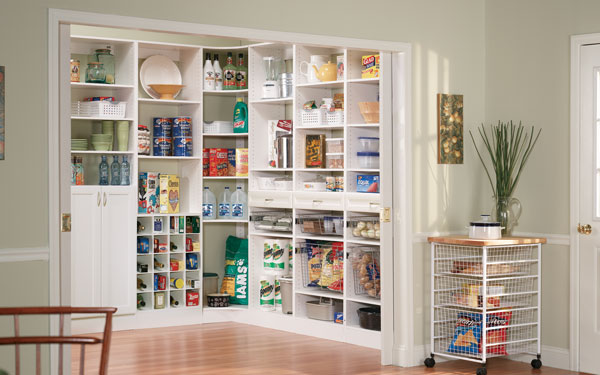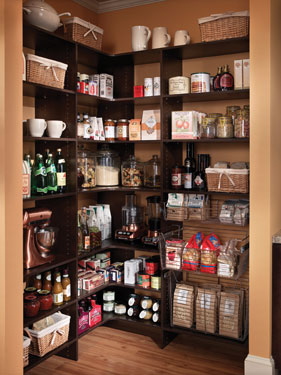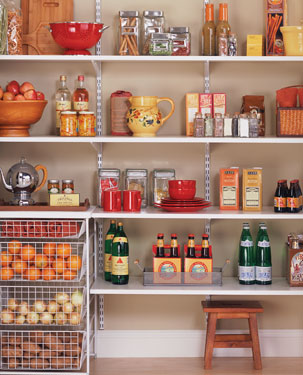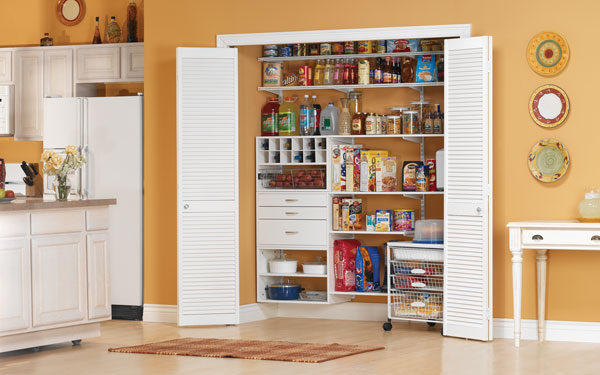 by Jennifer Jones
by Jennifer Jones

Photos above courtesy of ClosetMaid
It’s time to go to the pantry and look for something to cook for dinner. How come it always seems that your pantry is so full, but there’s still nothing to cook? Chances are, there are plenty of items ideal for whipping up a quick dinner, but you just can’t see them! Besides helping to maintain an organized home, an organized pantry could possibly save your family money too. If you can see all the items you have in your pantry in plain sight, then you will quickly be able to surmise if you have what you need.
Before you can begin to make your pantry clean and organized, you are probably going to have to clutter up your kitchen by removing everything in your kitchen pantry.
Photo to the left courtesy of ClosetMaid
Once you get everything out on the kitchen counter or a nearby table, you may notice that there’s a bit of clean up to do inside the pantry itself. Chocolate chips, spilled flour, chopped nuts, potato chip crumbs and other food debris may have snuck out of their bags or containers leaving a little bit of a mess. Wipe all shelves clean with soapy water using a mild detergent and make sure they are dry before putting anything back into the pantry.
Survey the items that you pulled out of your pantry. Are there coloring books, mittens and other random items that made their way there? If so, place these items in a laundry basket or box and keep them separated. After the kitchen pantry task is done, you can put these misplaced items into their proper place within your home. It’s best to stay focused on your pantry now and wait to get these miscellaneous items where they need to be later.
Next, before anything makes its way back into the pantry, check all freshness dates on every item. This includes both opened and unopened packages. Then, look at every item and see what things you simply won’t use or do not like. If you were on a diet last year and bought up a lot of diet foods just to find out you didn’t like them, then get rid of them. If you didn’t like them when you were on your diet, then you probably never will! The goal is to make sure that all the food items you have left to put back into your pantry are actually things you can see yourself using.
If you are left with items that are still fresh, but you simply don’t want, consider creating a box for food donations. A local food bank or church will be thrilled to accept most food items at any time.
Also, if you find a couple of open items that are the same, look for a way to combine them. If neither are stale, then combine these items so there are no duplicates.
Photos to the left courtesy of ClosetMaid
Now, arrange your items in categories for maximum effectiveness. Here are some suggestions on different categories to get you going: baking, canned goods, snacks, storage bags and wraps, cereal etc… Think about who may be using the different categories you are creating. If you have older children and trust their snack choices, then it may make sense to put this section within reach to your children. But, if you know that your little ones will raid the pantry if their favorite snacks are within reach the minute you turn your head, then perhaps this shelf needs to be a bit higher!
Many pantry items are suited for airtight containers in order to preserve their freshness. These include flour, sugar and pastas. But, you may want to use wire baskets or other open bins for individually wrapped items such as microwave popcorn, granola bars and instant oatmeal. Taking these items out of their bulky boxes will free-up space in your pantry while allowing you to easily see how much inventory you have on-hand. If you plan to use a variety of storage containers, then before putting everything back into the pantry, fill the storage containers and bins and get them ready to go back into your new organized pantry.
Now pick a shelf! You might feel comfortable working from the top to the bottom. The top shelf may be best for items your family does not use day-to-day. This will depend on you and your family. But, maybe you don’t bake unless it’s a special occasion, so baking items may be the perfect category to fill your top shelf. If you have many of the same items, then put them back into your pantry with the newest items in the back and the oldest items towards the front, then you will use up what you have in the proper order.
Then, another great category to work with is canned goods. It can often be helpful to get risers for these so you can see everything all the way to the back since most canned goods are the exact same height. Whatever works best for you, organize your canned goods by vegetables, fruits, beans, soups, etc…
If you and your family enjoy many types of ethnic foods and have a variety of sauces and ingredients for these meals, then you may want to create a section that houses Mexican or Chinese ingredients all in one spot. That way, when dinner time rolls around everything you need for a Mexican feast will be right at-hand.

Photos above courtesy of freedomRail
Many people enjoy having their oils, vinegars and cooking wines near their stove for ease when cooking, but if you prefer them in the pantry, then designate a specific spot for these with salad dressings and condiments nearby. Often these items work perfectly on door racks. So, you may decide to invest in a door rack for convenience with these items.
Coffee, tea and hot chocolate is another category that can be found in many pantries, but it is also perfect in a cabinet nearest your coffee maker for ease in the morning.
When it comes to heavy items such an oversized food jars bought in bulk, dog food or cases of bottled water, stick to the floor. It would be a shame to see one of your precious shelves bowed beyond belief from such heavy items. Plus, it may be deceiving and seem easy to grab if positioned on a higher shelf, but as soon as it hits your arms it may drop to the floor.
If you want to take this exercise in organizing one step further, then consider labeling your shelves so it will be easy for the entire family to take part in putting away the groceries when you get home from the store. Then, there will be less room for interpretation on where an item may seem to go.
Besides making you feel like you accomplished a task that was long overdue, cleaning and organizing your kitchen pantry may result in savings at the grocery store, more creative family meals and accidental stockpiling of certain foods. So, make this your next weekend task and start enjoying the long list of benefits to an organized pantry.
Please visit ClosetMaid.com and freedomRail.com for more information on the products featured.
Photos courtesy of freedomRail and ClosetMaid.
Here are some related articles:
Save this article to:
back to top